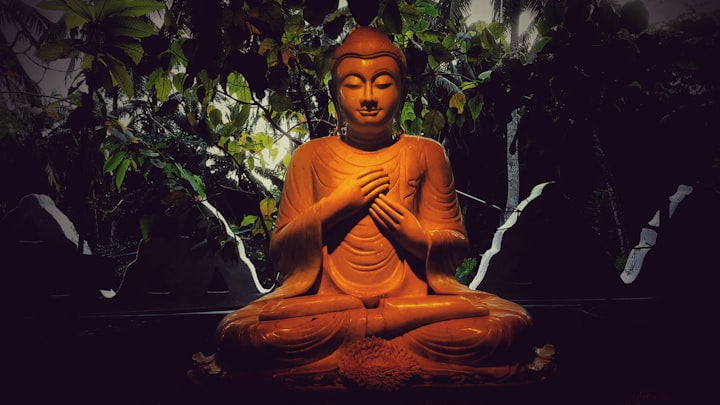Four Noble Truths of Buddhism | Find The Origin | Samudya (समुदय) | Sensitive Ears
See things as they are. Nothing more nothing less.

The four noble truths of Buddhism have been on my radar for some time. I heard about it during my Vipassana course in 2020. A speech from a fellow Toastmaster reignited my interest to write on it.
Some weeks back, I wrote about the 'First Noble Truth.' This initiative aims to find tools within Buddhism to manage anxiety. Vipassana, a Buddhist form of meditation, was the tool of my choice.
In the previous article on the first noble truth, we learned that suffering is inevitable. By writing about it, I wanted to bring people out of denial with anxiety. The biggest problem with anxiety is a lack of awareness. To manage anxiety, we need to identify the trigger points. Be proactive before the devil of anxiety can paralyze our cognitive capabilities.
Introduction
Anxiety is like a terrorist. It attacks your mental stability when you least accept it. In this article, I will extend on this topic. How can we use the second noble truth of Buddhism to identify the source of anxiety?
Expressing views via blogs demands freedom of words. Hence, I will divide my opinions on the second noble truth into two different articles:
- In the first article, I will introduce the second noble truth. In this story, I will use an example from my Vipassana practice. The experiences from this example will demonstrate strategies to manage anxiety.
- In the second article, I use another example from my Vipassana practice. The example would focus on psychosomatic pain and its management. These pain management strategies would also prove beneficial in coping with anxiety.
Samudya (समुदय) – Source of suffering
Buddhism's second noble truth is identifying the sources of suffering, i.e., Samudya (समुदय). Samudya is an essential concept in Buddhism, Jainism, and Hinduism. The word Samudya exists in both Pali and Sanskrit dictionaries. Both Pali and Sanskrit are ancient Indian languages.
Suffering originates from our cravings (Tanha तृष्णा) or desires for delight, pleasure, or passion. The word Tanha also exists in both Pali & Sanskrit dictionaries. The concept of Tanha is a subset of the second noble truth of Buddhism.
The attachment to craving or desire is never-ending. One desire leads to another. A lifespan is not enough to please all urges. We cannot do everything in one life. You will always have things unchecked in your bucket list. These cravings or unattended desires become the reason for reincarnation or rebirth.
Buddhism believes in the concept of rebirth. I believe moksha (or liberation) is the ultimate ending to all these cravings. Mokha is not only about life & death but liberation from worldly desires. Rebirth is pointless once there is nothing more to achieve, hence an ultimate end to the cycle of life and death.
Easier said than done. Isn't it? My response to the questions is that if we can't detach ourselves from cravings, let's become aware of them.
How does this help with anxiety?
What have we established until now? Suffering is the constant, and the reason behind suffering is our cravings; what's next? How does this knowledge help us with anxiety? After all, it's impossible to curb all our desires or cravings, but detaching ourselves from them is possible.
Each craving or desire has a cycle. We cannot stop these cravings but manage them. We need to address them with our mental strength. Let's dig deep to understand how Vipassana can help us build this mental strength.
We go to the gym to train our physical muscles. Meditation helps us in building mental muscles. During a Vipassana session, we experience sensations in our bodies. What are these sensations? How do we generate and acknowledge them? To learn more about these sensations, read my earlier articles.
Reaction to these sensations gives us a playing ground to develop mental strength. We learn to tame our minds to cravings during these meditation sessions. Some sensations are irritating, while others could be excruciating.
We instinctively respond to these negative sensations by attempting to halt them. The more we try to resist them, the more their intensity increases. Instead, observing these sensations helps manage the discomfort; watching them help us develop the mental muscle to deal with the pain. We can apply the same principles to anxiety once we learn the art of observing our sensations.
I will give two practical examples of these physical sensations. These are two of the toughest sensations I face during a session.
Sensitive Ears
I meditate in the morning after taking a shower. Five minutes into the session, I usually get a tingling sensation in my right ear. It's due to water droplets from the shower. The craving is to curb this sensation by breaking my pose and rubbing my ear. The urge to scratch the area around the ear is terrible. It's a ticklish sensation, and I'm not fond of it.
I beg for the sensation to end. It would be easiest to break the session and scratch the life out of my ear. As part of the recommendation from the Vipassana retreat, we need to maintain the pose for an hour. The challenge is to maintain a state of equanimity to all sensations.
After a few seconds, the sensation increases in intensity. There is no way to get out of it. The worst part is that the sensation will move from one place to another.
The perquisite of the practice is to have faith that the sensation eases out with time. Until it does, we need to continue observing. If the sensation stays for more than 2-3 minutes, we should scan the rest of the body to identify other sensations.
After a few minutes, other sensations in the body demand focus, and the itchiness around my ear eases off.
Learnings
In the above example, the sensation in the ear is suffering. It's inevitable. The craving is to scratch my ear for relief. Since the sensation appeared early in the session, I know I had to live with it for a long time.
It's the point; anxiety peeps in. I start wondering about the amount of time left in the session. There are times I could not hold on and break the pose. When it happens, I remind myself to improve with practice.
There will be many sensations like these during the entire session. At times, I surprise myself. Other times, I take it in my stride with determination for the next session. In the last 10-15 minutes of the session, I witness excruciating pain in my lower back. The pain builds up during the session but becomes unbearable at the end. It happens after sitting in the same posture for a long duration.
I realize the power of psychosomatic pain during these times. It's an empowering experience after I can control the intensity of the pain with my focus. It's an experience that deserves another article. Hence, I will end this article with a conclusion.
Conclusion
Our usual day is full of positive and negative experiences. All experiences are like sensations. Both positive and negative experiences have cravings attached. There are no guarantees on how long a positive or negative experience lasts. Still, detachment makes it easier to manage them.
thanks
Tarun





Comments (1)
This was very fascinating and informative. Very well written!